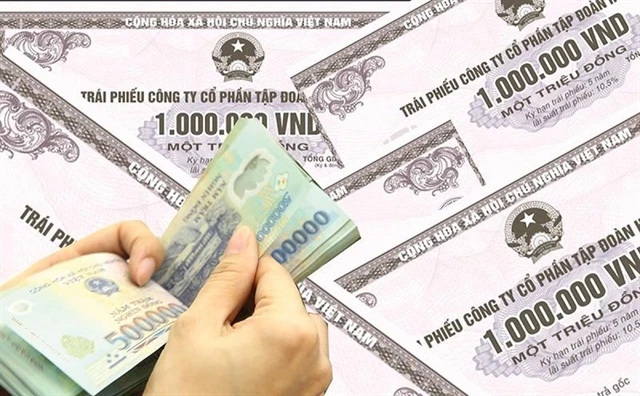
Despite a slew of policy interventions, credit growth has been sluggish, with the debt balance of real estate businesses surging.
"Excess Money" and the Scarcity of Borrowers
During a meeting convened to explore avenues for enhancing enterprises' access to credit capital and increasing the economy's capacity to absorb capital, Deputy Prime Minister Lê Minh Khái chaired the session, where Standing Deputy Governor of the State Bank Đào Minh Tú candidly acknowledged the unprecedented complexity in managing monetary policy. This predicament underscores the existence of an inventory of goods with businesses, an inventory of money with commercial banks, and the need to address the issue of "excess money" within the banking system.
Despite a continuous series of conferences to foster collaboration between banks and businesses and to solicit feedback, as well as efforts to enhance the legal framework governing credit activities and policies aimed at supporting interest rates and reducing lending rates, the provision of credit to the economy remains a daunting task. Businesses seem reluctant to borrow capital, and some customer groups are unable to meet loan requirements, especially small and medium-sized enterprises, compounded by the real estate sector's limited ability to absorb capital.
As of August 29, the economy's total credit stood at approximately VND 12.56 quadrillion, marking a 5.33% increase compared to the end of 2022. In contrast, during the same period in 2022, credit had surged by 9.87%. The State Bank attributes this slowdown to objective factors, including certain customer groups having unmet loan conditions, primarily small and medium-sized enterprises, and the impact of the real estate sector's capacity to absorb capital.
Pursuing Measures to Boost Output
Banks have taken proactive measures to stimulate credit this year. In the first half of the year, BIDV introduced 25 preferential credit packages totaling VND 484 trillion, reducing lending rates for businesses by 0.5-2% per year and for individuals by 1-1.5% per year. Vietcombank, on the other hand, implemented 10 reductions in deposit interest rates and 5 reductions in lending interest rates for individuals and businesses. Agribank adjusted lending interest rates seven times in the first nine months of the year. TPBank reduced interest rates eight times, with an aggregate reduction of 1.5-2.25% for existing loans by mid-August. Additionally, Sacombank, ACB, BVBank, OCB, VietBank, and others launched large-scale preferential credit packages. Many banks also developed segmented sales strategies, tailoring programs for specific customer groups and expanding overdraft lending.
In mid-August, the State Bank of Vietnam issued a directive instructing credit institutions to reduce interest rates on existing outstanding loans and new loans, aiming for a minimum annual interest rate reduction of 1.5-2%. September witnessed the launch of several preferential credit packages and new loan interest rate reduction initiatives. Following the implementation of Circular 06 by the State Bank on September 1, many banks began informing customers about attractive interest rates for loans aimed at repaying debts owed to other banks. Vietcombank, for instance, allowed individuals to borrow funds for early loan repayment at other banks, offering interest rates as low as 6.9% per year for the first six months, 7.5% per year for the initial 12 months, or 8% per year during the first 24 months. BIDV introduced interest rates starting from 6% per year for loans of less than 12 months and 6.8% per year for 12-month loans. VietinBank and Techcombank followed suit with similar loan products.
Will Capital Be Channelled into Production and Business?
In the pursuit of addressing the issue of "excess money," the key question arises: where can this capital be effectively directed? In a challenging capital access landscape, a bright spot emerges in the real estate sector. A simple comparison highlights this trend: outstanding debt for small and medium-sized enterprises in the first half of the year increased by nearly 4% compared to the end of 2022, while outstanding debt for real estate businesses soared by 17.41%, surpassing the 10.73% growth rate for the entire year of 2022.
The Government has reiterated its commitment to resolving difficulties plaguing the real estate market, emphasizing the need for the State Bank to review and encourage credit lending to real estate businesses, instruct commercial banks on adopting suitable and effective solutions to facilitate access to more favorable credit sources for businesses, real estate projects, and homebuyers. Special attention is placed on lending for incomplete and soon-to-be-completed real estate projects.
In line with Resolution 144/NQ-CP, which emerged during the regular Government meeting in August, the State Bank of Vietnam was tasked with expeditiously assessing and appropriately adjusting risk coefficients for various real estate segments. Though the State Bank's proposal related only to reducing the credit risk coefficient for social housing mortgage loans, the government's request through Resolution 144 underscores the imperative nature of addressing the real estate market's challenges. Given the developments in real estate credit and the fresh directives, the real estate sector is poised to absorb capital more readily.
However, banks must be vigilant to ensure that "easy money" is not encouraged. Recent market events have prompted many banks to exercise caution. Thus, while reviewing and promoting credit lending to real estate businesses or reducing credit risk coefficients may help address some market issues, these actions may not constitute a panacea for all challenges.
Some experts contend that the policies may primarily benefit real estate companies that have close ties with commercial banks. Concerns have emerged among several real estate businesses that they may be squeezed due to capital congestion and difficulties accessing credit, particularly those businesses without direct connections to banking insiders. This issue warrants attention to ensure that general policies do not disproportionately favor select groups.




















